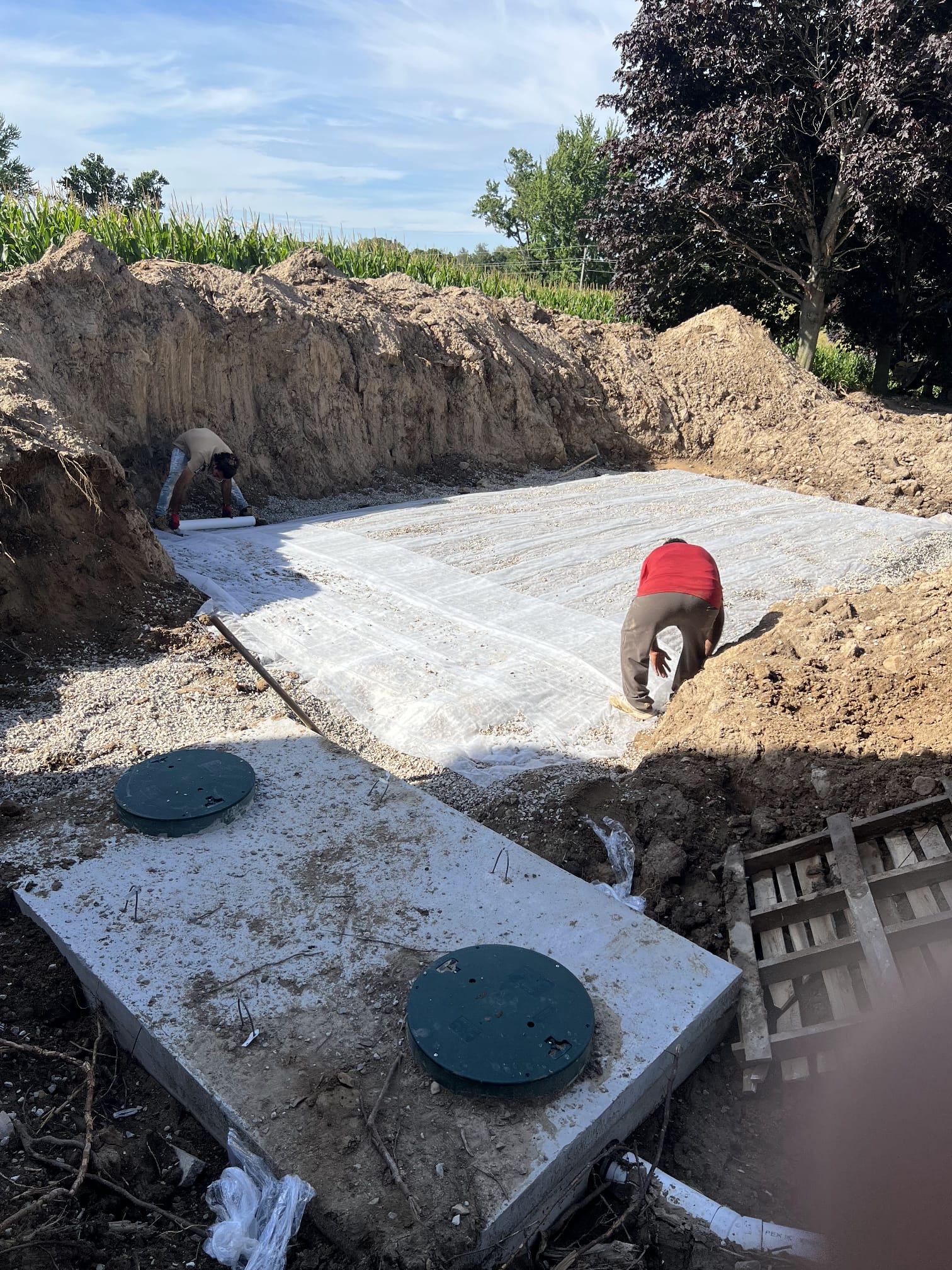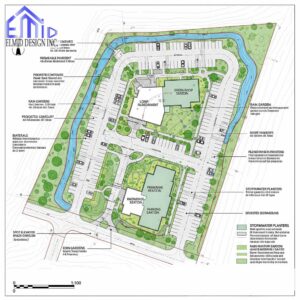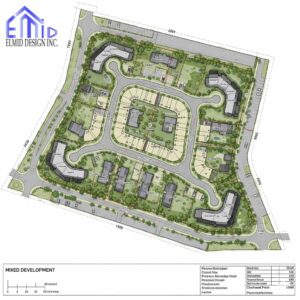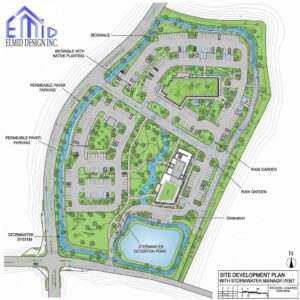Septic design Pickering is essential for properties in areas not connected to the municipal sewer system. It ensures wastewater is treated and disposed of safely while protecting the environment and public health. Pickering’s varied soil conditions, topography, and groundwater levels make professional septic design critical for long-term system reliability. Proper design involves analyzing soil permeability, determining the correct tank size, and following Ontario Building Code standards. Working with licensed engineers such as those at Elmid Design Inc—authorized by Professional Engineers Ontario—guarantees that every septic design meets strict regulatory requirements, supports sustainable development, and safeguards local water resources in Pickering.
Understanding Septic Design in Pickering
Septic design Pickering involves planning, sizing, and engineering an on-site wastewater treatment system tailored to the property’s conditions. Each design begins with an evaluation of the lot to determine how wastewater can be safely absorbed and filtered by the soil. The goal is to manage household waste efficiently without polluting groundwater or surface water. In Pickering, some properties lie in areas with higher groundwater levels or clay-based soils, which require special system configurations. Engineers design systems that handle these challenges while meeting code standards. A proper design ensures that wastewater treatment remains effective, minimizing maintenance and environmental risks.
Regulatory Framework for Septic Systems in Pickering
Every septic design Pickering must comply with Ontario’s Building Code, specifically Part 8, which governs small sewage systems. This section outlines design and installation requirements such as minimum distances from wells, property lines, and buildings. The Durham Region Health Department oversees permit approvals in Pickering, reviewing all designs before construction begins. This review process confirms that the system will not contaminate water sources or harm the environment. Only qualified designers or licensed engineers can prepare and submit septic design applications. Compliance with these regulations ensures the safety, performance, and legal approval of each system built in Pickering.
Site Evaluation and Soil Testing in Pickering
A successful septic design Pickering starts with a comprehensive site evaluation. Engineers conduct soil tests to determine how quickly the ground can absorb and filter wastewater. This percolation or “T-time” test identifies whether the soil can handle a conventional system or if an alternative design is required. The evaluation also considers slope, vegetation, bedrock depth, and seasonal water levels. Clay soils absorb water slowly and may need raised beds or tertiary treatment, while sandy soils require careful flow control to prevent groundwater contamination. Site data collected during this stage forms the foundation for a reliable and compliant design.
Sizing the Septic System in Pickering
Proper sizing is the core of septic design Pickering because it determines how efficiently the system will operate. Engineers calculate the system’s daily design flow based on the number of bedrooms, bathrooms, and fixtures in the home. The Ontario Building Code specifies flow rates and minimum tank capacities for residential systems. An undersized system can overload quickly, leading to backup or groundwater contamination. Oversizing may waste materials and increase costs unnecessarily. The engineer ensures the tank and leaching bed match property needs and soil absorption capabilities. Accurate sizing helps achieve long-term reliability and cost efficiency.
Types of Septic System Designs in Pickering
Different properties in Pickering require different types of septic systems depending on soil, space, and groundwater conditions. The most common type is the conventional gravity system, which relies on natural soil absorption. However, properties with high water tables or limited lot areas often require advanced systems like pressure distribution or raised filter beds. Tertiary treatment systems offer enhanced purification where soil conditions are poor or environmental sensitivity is high. Engineers select the appropriate system based on test data and site conditions to ensure compliance and sustainability. Choosing the correct type protects both property and ecosystem health.
Engineering and Professional Oversight
Professional oversight is a vital part of septic design Pickering. Licensed engineers from firms like Elmid Design Inc provide expert analysis, technical drawings, and compliance assurance. Their designs are based on detailed soil and hydraulic data, ensuring accuracy and safety. With authorization from Professional Engineers Ontario, Elmid Design Inc guarantees that each project meets provincial and municipal standards. Professional involvement reduces the risk of errors, non-compliance, and environmental damage. It also provides property owners with a legally recognized design that supports building permit approvals and long-term system performance. This engineering supervision is essential for dependable septic solutions.
Drawing Preparation and Documentation
In septic design Pickering, drawing preparation involves creating detailed plans that show the exact layout of the system. Engineers include the location of the septic tank, leaching bed, reserve area, house footprint, wells, and property lines. Elevations and slopes are shown to ensure proper drainage and gravity flow. These drawings accompany a design report summarizing soil test results, design assumptions, and flow calculations. Documentation must be precise because inaccuracies can delay permit approval or lead to costly revisions. Professionally prepared drawings demonstrate compliance and make construction easier for contractors following the approved plan.
Permitting and Approval Process
Once drawings and documents are complete, the septic design Pickering is submitted to the Durham Region Health Department for review. The department evaluates the design’s compliance with the Ontario Building Code and environmental regulations. Any discrepancies are returned for correction before approval. This process ensures that the system will perform safely without risk to groundwater or neighboring properties. Once approved, a permit is issued, allowing installation to proceed legally. Timely and accurate submissions reduce delays and prevent fines or future legal issues. Working with professional engineers streamlines this approval process and ensures smooth project completion.
Installation and Construction Considerations
During installation, septic design Pickering becomes a reality. The contractor follows the engineered drawings exactly to maintain design integrity. Tank placement, trench depth, and pipe slope are measured precisely to meet hydraulic and soil requirements. Engineers often inspect during installation to verify compliance and prevent errors. Deviations from the approved plan can cause performance issues, so oversight is crucial. Proper installation materials, including watertight tanks and high-quality pipes, ensure durability. Each construction phase must align with approved specifications to guarantee long-term reliability. Professional supervision minimizes risks and protects the homeowner’s investment.
Common Site Challenges in Pickering
Pickering’s geological diversity creates several challenges in septic design. Clay-based soils common in certain regions drain poorly, requiring alternative systems such as raised beds or tertiary treatment. Properties near Lake Ontario or wetlands often face high groundwater levels, demanding special design considerations to protect water quality. Limited lot sizes in developed areas may restrict system placement, requiring innovative layouts or advanced treatment technologies. Professional engineers address these challenges with customized solutions that meet both performance goals and legal requirements. Tailoring designs to Pickering’s landscape ensures lasting efficiency and environmental protection.
Environmental and Public Health Considerations
Septic design Pickering plays a vital role in protecting public health and the environment. A properly designed system prevents harmful bacteria, nutrients, and chemicals from entering groundwater and nearby waterways. Engineers ensure that effluent is treated within the soil’s natural filtration capacity before reaching the water table. This process preserves clean drinking water sources and safeguards local ecosystems. The Ontario Building Code’s strict standards exist to maintain these protections, and compliance is essential. When properly managed, septic systems contribute to sustainable development and community well-being in Pickering.
Why Choose Elmid Design Inc for Septic Design in Pickering
Elmid Design Inc stands out as a leading provider of septic design Pickering because of its engineering expertise, commitment to quality, and local experience. The firm holds a certificate of authorization from Professional Engineers Ontario, confirming its credibility and adherence to professional standards. Its team understands the local soil conditions, regulatory framework, and environmental challenges unique to Pickering. Every project is handled with precision, ensuring compliance and reliability. By working with Elmid Design Inc, homeowners receive not only professional septic design but also trusted guidance through testing, documentation, and permit approval.
Value of Professional Expertise in Long-Term Performance
Professional expertise ensures that septic design Pickering performs efficiently for decades. Licensed engineers use data-driven methods to predict system behavior under different conditions. Their designs prevent overflow, reduce environmental risk, and extend system life. They also educate homeowners on maintenance practices to sustain optimal function. The collaboration between engineers and property owners promotes accountability and efficiency. Investing in professional design saves money by avoiding future repairs and ensures environmental compliance. In a community like Pickering, where growth and sustainability are priorities, expert engineering remains the cornerstone of safe wastewater management.
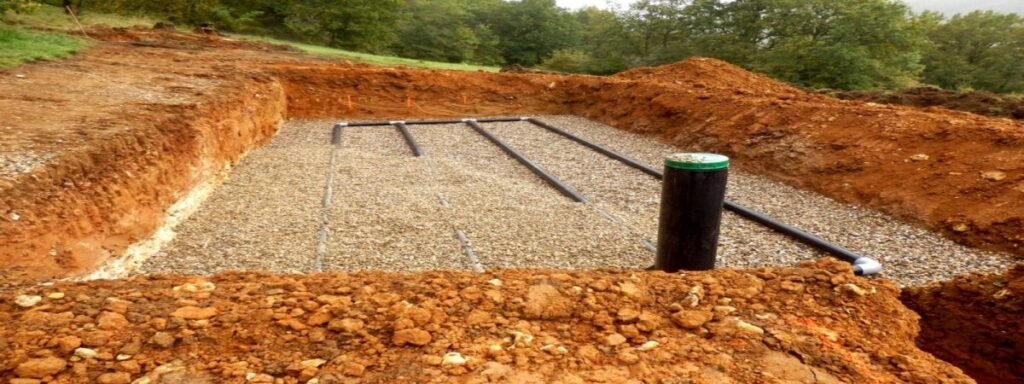
Drawing and Permitting Process for Septic Design Pickering
The drawing and permitting stage is a vital part of septic design Pickering. Engineers prepare detailed drawings that show every part of the system, including the septic tank, leaching bed, reserve area, and any elevation details. These drawings must follow Ontario Building Code Part 8 standards and include accurate measurements. Each design also comes with a report that explains soil test results, daily flow calculations, and compliance details. The submission is then reviewed by the Durham Region Health Department, which ensures the system meets environmental safety requirements. Professional engineers verify that every document and drawing meets the necessary technical standards before it is sent for approval, reducing the risk of delays or rejections.
Installation and Construction Considerations in Pickering
Once the permit is approved, the installation phase of septic design Pickering begins. Construction must follow the engineered drawings precisely to ensure system integrity and proper function. The process includes excavation, tank placement, pipe installation, and leaching bed construction. Engineers monitor the installation to confirm that the slope, depth, and layout meet design requirements. Using approved materials and following proper compaction techniques prevents structural issues and leakage. In Pickering’s diverse soil conditions, careful attention during installation protects both the system and the surrounding environment. Engineering oversight ensures that the final system performs efficiently and meets provincial health and safety standards.
Inspection and Final Approval Process
After construction, the septic design Pickering system undergoes an inspection by the health authority. Inspectors verify that installation matches the approved design and that materials meet all code specifications. They check elevations, drainage paths, and leaching bed construction for accuracy. Engineers often attend these inspections to provide clarification or confirm compliance. Once all elements are verified, the system receives final approval for operation. This inspection guarantees that the septic system is safe, efficient, and environmentally sound before being used. Compliance at this stage is essential because it ensures the property meets local and provincial regulations while maintaining long-term performance.
Maintenance and Long-Term Operation
Maintenance plays a critical role in the success of septic design Pickering. A properly maintained system can operate effectively for decades. Regular pumping prevents solids from entering the leaching bed, and routine inspections help identify potential issues before they become serious. Engineers recommend monitoring water usage to prevent overloading the system, which can cause premature failure. Pickering’s seasonal changes, such as spring thaw and heavy rainfall, can affect soil absorption, making consistent maintenance important. Keeping maintenance records and following professional recommendations ensure system efficiency and protect property value. A well-maintained system supports environmental protection and community health across the region.
Cost Factors in Septic Design Pickering
The cost of septic design Pickering varies based on property conditions, soil type, and system complexity. Factors such as lot size, groundwater level, and treatment system type directly influence total expenses. Designs for smaller properties or areas with poor drainage often require advanced treatment systems, which increase costs. Professional engineering services may seem like an additional expense, but they prevent costly redesigns or failures. Engineers provide accurate cost estimates during the design stage to help homeowners budget effectively. Investing in quality design and construction delivers long-term savings by ensuring durability and reducing future maintenance or replacement costs.
Common Mistakes Homeowners Should Avoid
Homeowners often make mistakes during septic design Pickering projects when they underestimate the importance of professional involvement. Using unqualified designers or ignoring local regulations can result in denied permits and system failures. Another mistake is skipping soil evaluation, which leads to inaccurate system sizing and poor performance. Improper installation or lack of regular maintenance also shortens the system’s lifespan. Professional engineers ensure these errors are avoided through data-driven design and supervision. By following expert advice and maintaining compliance with the Ontario Building Code, homeowners can prevent costly repairs and protect their property and the environment.
Technological Innovations in Septic Systems
Technological advancements continue to enhance septic design Pickering. Modern systems now use sensors and digital monitoring to track performance and identify issues early. Aerobic and tertiary treatment units improve wastewater quality and reduce environmental impact. Engineers use computer-assisted modeling to design systems that optimize flow distribution and maximize soil absorption. These innovations make septic systems more efficient and sustainable. In Pickering, where environmental awareness and urban expansion coexist, advanced design methods ensure that wastewater treatment remains safe, reliable, and future-ready. Professional engineering firms incorporate these technologies to deliver systems that exceed regulatory and environmental standards.
Environmental Protection and Groundwater Safety
Groundwater protection is central to septic design Pickering. Engineers design systems that maintain safe separation distances between wastewater discharge and the water table. They ensure the soil acts as a natural filter, removing harmful bacteria and nutrients before they reach groundwater. Proper system design prevents contamination of wells and nearby surface water. In Pickering, this is especially important due to the city’s proximity to Lake Ontario and its sensitive ecosystems. Engineering precision and compliance with environmental regulations ensure every system operates safely. These designs protect both private properties and the broader community from pollution risks.
The Role of Professional Engineers
Professional engineers play an essential role in septic design Pickering. Their training and certification allow them to analyze complex site data and create safe, compliant designs. They oversee every phase of the project, from site testing to system approval. Elmid Design Inc, authorized by Professional Engineers Ontario, represents the highest level of professional integrity in this field. Their engineers ensure that every design meets code, environmental standards, and technical requirements. The involvement of licensed professionals also provides homeowners with legal protection, guaranteeing that all designs and installations are completed responsibly and accurately.
Importance of Regulatory Compliance
Regulatory compliance ensures the safety, legality, and performance of septic design Pickering. Following Ontario Building Code Part 8 protects both homeowners and the environment. Noncompliance can result in fines, denied occupancy permits, or system failure. Engineers at Elmid Design Inc are experienced in navigating these regulations, ensuring every project receives proper approval. Their designs reflect a deep understanding of both municipal and provincial standards. Compliance not only protects property value but also upholds environmental integrity. Every approved septic design demonstrates adherence to professional engineering principles and the strict requirements of the Durham Region Health Department.
Long-Term Value of Professional Design
Professional septic design Pickering offers long-term value through reliability, safety, and environmental protection. An engineered system reduces the likelihood of breakdowns and maintains consistent performance under varying conditions. Professional design extends system lifespan, reduces maintenance costs, and ensures compliance with future regulations. Homeowners gain confidence knowing their investment is protected by technical expertise and ethical responsibility. Elmid Design Inc provides engineering services that prioritize performance and sustainability. Their proven track record of successful septic system designs across Pickering demonstrates their commitment to professional excellence and community safety.
Sustainable Development Through Engineering Expertise
Sustainability is an important aspect of septic design Pickering. Engineers design systems that use natural filtration processes and energy-efficient components to reduce environmental impact. By integrating advanced treatment technologies, they help conserve water and protect groundwater quality. Sustainable design supports responsible urban expansion while maintaining environmental balance. Professional engineering firms like Elmid Design Inc lead these efforts by applying science-based solutions that align with Ontario’s sustainability goals. Their work ensures that new developments in Pickering can grow responsibly without compromising the region’s natural resources or community health.
Future Trends in Septic System Design
The future of septic design Pickering focuses on innovation and digital integration. Smart monitoring systems will allow engineers and homeowners to detect system performance changes in real time. Environmentally friendly materials and modular designs will reduce installation time and improve efficiency. Data-driven analysis will help predict system maintenance needs before issues arise. Engineers will continue to refine wastewater treatment technologies to meet stricter environmental standards. These advancements reflect the commitment of professional engineering firms to continuous improvement. Pickering’s growing demand for sustainable infrastructure ensures that septic design will remain a vital part of local development.
Advanced Engineering Approaches in Septic Design Pickering
Advanced engineering methods are redefining septic design Pickering by using data analysis, digital mapping, and computer modeling. Engineers now use 3D terrain scanning and hydraulic simulations to predict how wastewater will move through soil layers. These tools allow them to identify drainage limitations before installation begins. This precision ensures that every design functions efficiently under real site conditions. Using advanced engineering technology also reduces long-term maintenance costs by optimizing system capacity and preventing early failures. The result is a modern, environmentally responsible septic system that reflects both engineering innovation and compliance with Ontario’s environmental protection goals.
Site Adaptation and Local Soil Challenges
Every property in Pickering presents unique challenges that influence the final septic design. Soil composition can vary significantly, from dense clay to loose sand, each requiring a customized approach. Clay soils retain water and demand raised bed systems or pressurized distribution to ensure even effluent dispersal. Sandy soils allow faster absorption but need careful control to avoid groundwater contamination. Professional engineers conduct precise tests to understand these variations and design systems that balance safety, performance, and efficiency. Tailoring each septic design Pickering project to local soil conditions guarantees durability and regulatory compliance while protecting the surrounding ecosystem.
Climate and Seasonal Considerations
Pickering’s climate adds complexity to septic system design and performance. Seasonal changes such as freeze-thaw cycles, rainfall intensity, and snowmelt impact how effluent moves through the soil. Engineers account for these variations when planning depth, insulation, and flow distribution. A well-designed system resists frost damage, prevents surface pooling, and maintains stable treatment levels year-round. Adapting septic design Pickering to the local climate ensures long-term reliability and environmental protection. Professional engineering analysis helps anticipate these challenges, creating systems that perform consistently even under severe seasonal stress. This attention to environmental detail reflects engineering precision and sustainability.
Integration of Tertiary Treatment Systems
Tertiary treatment systems represent the highest level of wastewater purification in septic design Pickering. These systems use biological or mechanical processes to remove nutrients and pathogens from effluent before it enters the leaching bed. They are often used on properties with small lot sizes or near environmentally sensitive areas such as wetlands and lakes. Engineers design these systems to exceed minimum regulatory standards while remaining cost-efficient and easy to maintain. Their inclusion enhances effluent quality and reduces environmental risks. By integrating advanced treatment units, professional engineers help Pickering homeowners meet the city’s growing sustainability and environmental goals.
Monitoring and Maintenance Innovations
Monitoring innovations are transforming how septic design Pickering systems are maintained. Engineers now include monitoring ports, sampling chambers, and digital sensors that measure tank levels and flow rates. This data allows early detection of performance issues before they cause system failure. Continuous monitoring also provides valuable insight into how seasonal or usage changes affect performance. Engineers use these results to make design improvements and recommend optimized maintenance schedules. These innovations promote long-term system efficiency and environmental protection. A well-monitored septic system not only prevents breakdowns but also supports the sustainable management of wastewater in Pickering’s growing communities.
The Role of Elmid Design Inc in Engineering Excellence
Elmid Design Inc has established itself as a leading authority in septic design Pickering by combining engineering expertise, technical precision, and regulatory compliance. Holding a certificate of authorization from Professional Engineers Ontario, the firm demonstrates its commitment to high professional standards. Its engineers evaluate site conditions, perform soil tests, and develop customized designs that comply with local and provincial requirements. Their work emphasizes sustainability, reliability, and environmental protection. Elmid Design Inc’s focus on continuous improvement and technical innovation ensures that every septic system functions efficiently, providing long-term value and peace of mind for property owners in Pickering.
Importance of Homeowner Education
Homeowner awareness plays a major role in the success of septic design Pickering. Even the most advanced systems require responsible usage and regular maintenance to remain efficient. Educating property owners about proper waste disposal, water conservation, and maintenance schedules prevents system overloading and extends lifespan. Engineers often provide guidance on how to monitor tank performance and recognize early warning signs. Knowledgeable homeowners protect both their investments and the environment. In Pickering, community education supports sustainable wastewater management and helps maintain public health standards across both residential and rural developments.
Sustainable Design and Environmental Responsibility
Sustainability guides every step of septic design Pickering. Engineers incorporate eco-friendly technologies and natural filtration methods to reduce environmental impact. Modern designs focus on conserving water, improving treatment efficiency, and protecting groundwater quality. Sustainable design ensures that Pickering’s growth does not come at the expense of its natural ecosystems. By prioritizing long-term environmental health, professional engineers help the city meet its development goals responsibly. These systems demonstrate that sustainability and infrastructure development can work together effectively when supported by strong engineering principles and local regulatory compliance.
Future-Ready Septic Systems in Pickering
The future of septic design Pickering lies in adaptability and intelligent technology. Engineers are developing modular systems that can be upgraded as property needs evolve or regulations change. Remote monitoring and automated control systems will allow real-time adjustments to system performance. These future-ready designs reduce maintenance costs, extend lifespan, and provide greater environmental security. Pickering’s continued development requires wastewater solutions that are both innovative and resilient. By combining engineering precision with emerging technology, modern septic systems will continue to protect public health and support sustainable urban growth across the region.
Professional Accountability and Trust
Trust and accountability are central to professional septic design Pickering. Homeowners depend on engineers to create safe, effective systems that meet all legal and technical requirements. Licensed professionals, such as those at Elmid Design Inc, are bound by provincial standards that ensure transparency, safety, and ethical practice. This accountability guarantees that every design reflects scientific accuracy and environmental responsibility. Professional engineers take full responsibility for the performance and compliance of their work, building lasting trust with clients and regulatory bodies. In Pickering, professional accountability reinforces community confidence and ensures consistent quality in wastewater design.
Engineering Collaboration and Community Growth
Septic design Pickering contributes to more than individual properties—it supports community growth and infrastructure resilience. Professional engineering firms collaborate with homeowners, contractors, and local authorities to design systems that meet both immediate and long-term needs. These designs help balance development with environmental protection, allowing the city to expand without compromising public safety. Engineering collaboration also fosters innovation, encouraging new methods that reduce construction impact and improve efficiency. As Pickering continues to grow, septic system design remains a cornerstone of sustainable development guided by engineering expertise and regulatory compliance.
Commitment to Local Expertise
Local expertise defines successful septic design Pickering. Understanding regional soil types, hydrological conditions, and local bylaws allows engineers to create systems suited specifically to the area. Firms like Elmid Design Inc apply their knowledge of Pickering’s terrain to design systems that withstand the region’s environmental pressures. Their familiarity with local approval processes also ensures smoother permitting and faster project completion. Local engineering knowledge transforms septic system design into a service built on precision, trust, and long-term success. This commitment to local understanding makes each project more effective and environmentally sound.
Frequently Asked Questions
Who can design septic systems in Pickering?
Only licensed professional engineers or registered designers with Building Code Identification Numbers are legally authorized to prepare and submit septic system designs in Ontario.
How long does a septic system last in Pickering?
With proper design, installation, and maintenance, a septic system can last over twenty-five years. Soil type, water usage, and maintenance frequency influence longevity.
What permits are required for septic design Pickering?
All septic system installations require approval under the Ontario Building Code Part 8, typically reviewed by the Durham Region Health Department before construction begins.
What are the main causes of septic system failure?
Improper installation, poor design, and lack of maintenance are leading causes of failure. Overloading the system or ignoring regular inspections can also reduce performance.
Why should I hire Elmid Design Inc for septic design in Pickering?
Elmid Design Inc provides licensed engineering services backed by Professional Engineers Ontario authorization. Their designs combine technical precision, local expertise, and environmental responsibility for long-term reliability.

Trusted Engineering Experts in Ontario
Elmid Design Inc is a licensed engineering firm providing professional septic design Pickering and advanced civil engineering solutions across Ontario. Backed by a certificate of authorization from Professional Engineers Ontario, the company delivers reliable, regulation-compliant designs focused on safety, efficiency, and sustainability. Its team of experienced engineers uses data-driven methods and local expertise to ensure every project meets environmental and building standards. Homeowners and developers rely on Elmid Design Inc for precise engineering, transparent service, and trusted results that protect both property value and community well-being.
Geographic Locations That We Service:
Our Licensed Professional Engineers specializing in Engineered Site Grading Plans offer the best-engineered site grading plan, lot grading and erosion plan, and drainage plan to obtain site plan approval and building permits in Ontario, including a wide range of municipalities. Each area boasts unique features and requirements, making our tailored approach essential for success.
Toronto and Surrounding Areas
In the vibrant heart of Ontario, we service Toronto (City of Toronto) and surrounding areas. Additionally, we cover Oshawa (City of Oshawa), Pickering (City of Pickering), and Clarington (Municipality of Clarington). Furthermore, our expertise extends to Ajax (Town of Ajax), Whitby (Town of Whitby), Brock (Township of Brock), Scugog (Township of Scugog and Uxbridge (Township of Uxbridge).
Halton Region
Moving to the Halton Region, our services encompass Burlington (City of Burlington) and Halton Hills (Town of Halton Hills). Also included are Milton (Town of Milton) and Oakville (Town of Oakville).
Peel Region
In the Peel Region, we provide services in Brampton (City of Brampton), Mississauga (City of Mississauga), and Caledon (Town of Caledon).
York Region
Our services in the York Region cover Vaughan (City of Vaughan), Aurora (Town of Aurora), and East Gwillimbury (Town of East Gwillimbury). We also cater to Georgina (Town of Georgina), Markham (City of Markham), Newmarket (Town of Newmarket), Richmond Hill (City of Richmond Hill), Whitchurch-Stouffville (Town of Whitchurch-Stouffville), King (Township of King), and Bradford-West Gwillimbury (Town of Bradford-West Gwillimbury). Each municipality here offers a distinct setting, requiring our specialized approach.
Other Southern Ontario Cities and Towns
We also serve many other cities and towns in Southern Ontario. These include Hamilton (City of Hamilton), St. Catharines (City of St. Catharines), Niagara on the Lake (Town of Niagara on the Lake), Brant (County of Brant), Cambridge (City of Cambridge), Kitchener (City of Kitchener), Waterloo (City of Waterloo), and Woodstock (City of Woodstock). Furthermore, we operate in Guelph (City of Guelph), Centre Wellington (Township of Centre Wellington), Shelburne (Town of Shelburne), Orangeville (Town of Orangeville), New Tecumseth (Town of New Tecumseth), Essa (Town of Essa), Collingwood (Town of Collingwood), Wasaga Beach (Town of Wasaga Beach), Barrie (City of Barrie), Midland (Town of Midland), Orillia (City of Orillia), Ramara (Town of Ramara), Minden Hills (Town of Minden Hills), North Kawartha (Town of North Kawartha), Kawartha Lakes (City of Kawartha Lakes), Peterborough (City of Peterborough), Selwyn (Town of Selwyn), and Brighton (Municipality of Brighton).

